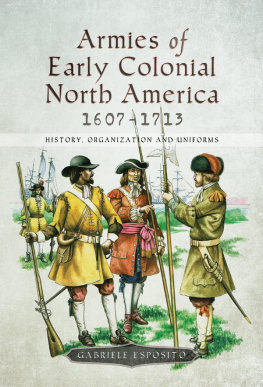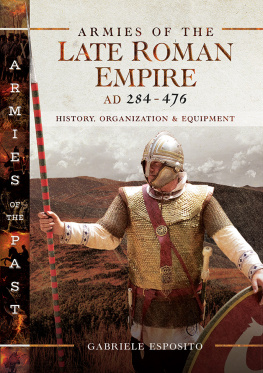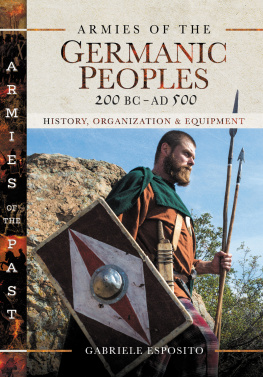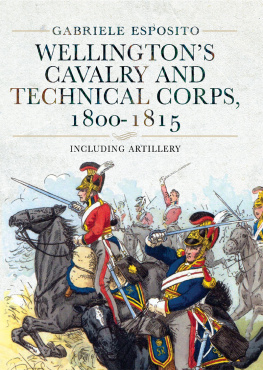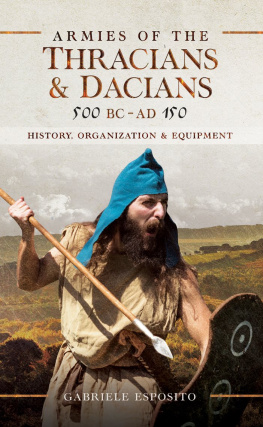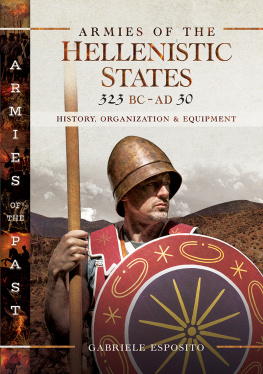
Armies of Early Colonial North America 16071713
Armies of Early Colonial North America 16071713
History, Organization and Uniforms
By Gabriele Esposito
First published in Great Britain in 2018 by
Pen & Sword Military
an imprint of
Pen & Sword Books Ltd
47 Church Street
Barnsley
South Yorkshire
S70 2AS
Copyright Gabriele Esposito, 2018
ISBN 978 1 52672 521 9
eISBN 978 1 5267 2523 3
Mobi ISBN 978 1 5267 2522 6
The right of Gabriele Esposito to be identified as Author of this work has been asserted by him in accordance with the Copyright, Designs and Patents Act 1988.
A CIP catalogue record for this book is
available from the British Library.
All rights reserved. No part of this book may be reproduced or transmitted in any form or by any means, electronic or mechanical including photocopying, recording or by any information storage and retrieval system, without permission from the Publisher in writing.
Pen & Sword Books Limited incorporates the imprints of Atlas, Archaeology, Aviation,
Discovery, Family History, Fiction, History, Maritime, Military, Military Classics, Politics,
Select, Transport, True Crime, Air World, Frontline Publishing, Leo Cooper, Remember When,
Seaforth Publishing, The Praetorian Press, Wharncliffe Local History, Wharncliffe Transport,
Wharncliffe True Crime and White Owl.
For a complete list of Pen & Sword titles please contact
PEN & SWORD BOOKS LIMITED
47 Church Street, Barnsley, South Yorkshire, S70 2AS, England
E-mail:
Website: www.pen-and-sword.co.uk
G abriele Esposito is a military historian who works as a freelance author and researcher for some of the most important publishing houses in the military history sector. In particular, he is an expert specializing in uniformology: his interests and expertise range from the ancient civilizations to modern post-colonial conflicts. During recent years he has conducted and published several researches on the military history of the Latin American countries, with special attention on the War of the Triple Alliance and the War of the Pacific. He is among the leading experts on the military history of the Italian Wars of Unification and the Spanish Carlist Wars. His books and essays are published on a regular basis by Osprey Publishing, Winged Hussar Publishing and Partizan Press; he is also the author of numerous military history articles appearing in specialized magazines like Ancient Warfare Magazine, Medieval Warfare Magazine, Classic Arms & Militaria Magazine, History of War, Guerres et Histoire, Focus Storia and Storie di guerre e guerrieri .
Acknowledgements
T his book is dedicated to my parents, Maria Rosaria and Benedetto, for their unconditioned love and support during all phases of my life. A very special mention goes to The Company of Military Historians for giving me permission to use several colour plates from their magnificent collection devoted to the uniformology of the Americas. A special thank-you goes to Dave Sullivan, the administrator of The Company of Military Historians, who made all this possible with his generous efforts. A special thought goes to all the artists and experts who collaborated over the years to create this fantastic selection of plates; in particular, I want to express my personal admiration for Ren Chartrand, whose pioneering publications were of fundamental importance for the researches of this book.
Introduction
T he main aim of this book is to study a very little-known period of North American military history: the early era of British and French colonization. Many people around the world think that the military history of the USA and Canada started with the French-Indian War or the US War of Independence: one of the objectives of this book is to show precisely how this general assumption is wrong, by illustrating in a concise but complete way all the main military events happening in North America during the years 16071713. Ive decided, for reasons of space, to limit the analysis of this volume to the Thirteen Colonies and Canada, thus not including the Spanish colonies founded in the territory of the modern United States (like Florida): after all, their origins and development are quite similar to those of Spanish Central America and thus deserve another study entirely devoted to them.
Regarding the temporal arch of this book, it starts with the establishment of the first successful English colony in North America: Jamestown on 14 May 1607. After covering all the seventeenth century, our journey in colonial America will stop with the end of Queen Annes War (17021713), which was nothing other than the North American theatre of operations of the Spanish Succession War. The Treaty of Utrecht, which ended that conflict, had very important consequences for North America, setting the stage for the future great wars of the eighteenth century that culminated in the French-Indian War and led to the start of the American Revolution in 1775.
In addition to the colonial American forces raised by the English and French, this book will also cover the regular units sent from England and France for service in the Americas. Obviously, this is not a book with the ambition of covering all military aspects related to the English and French armies of this period: the text will limit itself to the role that the European contingents had in the military development of the American colonies. In addition, some sections of this study will be devoted to two other European colonial powers which were minor participants in the colonization of North America: Sweden and the Netherlands. For a long time the history of New Sweden and New Netherland has been considered a secondary episode in the formation of the USA and thus has never been studied in a complete way: this book will try to end this situation, at least regarding the military aspects of the colonization.
Finally, there will also be some space for the Indian tribes of North America: after all, most of the fighting which took place in the Americas during 16071713 was conducted against them. The Indians described in this book are very different from those who are present in our common imagery: in the seventeenth century, the real military power in the Americas was them, not the small European colonies that were just forming and developing. In fact, one of the greatest achievements of the early American colonial forces was that of resisting the superior military forces of the indigenous inhabitants. The great continental wars between European colonial powers happened only at a later stage, when the local enemies were no longer a serious menace for the existence of the European settlements.
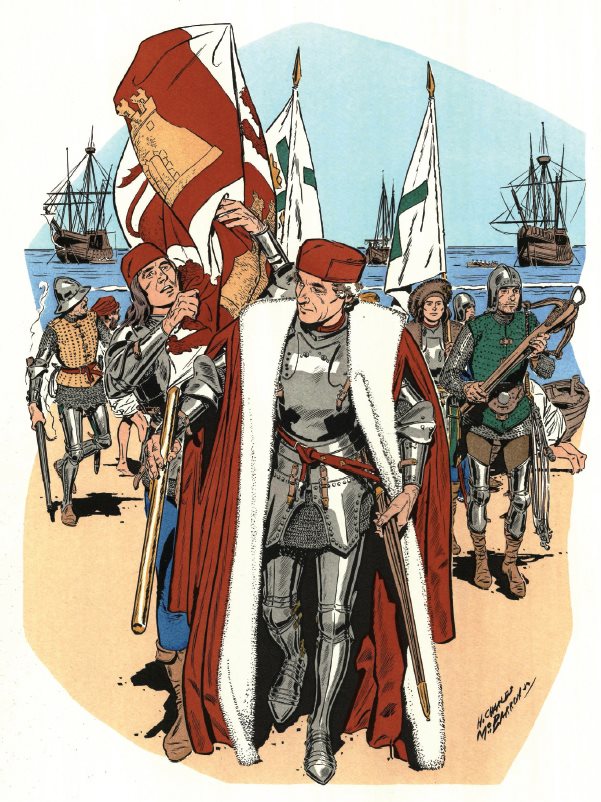
Columbus expeditions to America 14921496, by H. Charles McBarron, MUIA Pl. 281 , The Company of Military Historians.
Chapter 1
The early colonization of North America
The first explorations
T he first European settlers in North America were the Vikings, who arrived on the eastern coast of Canada during their explorations of North Atlantic in the late tenth century. The Norse settlement in what was known as Vinland, however, ended with failure after only a few years of existence. In 1494, following Columbuss discovery of the New World two years before, the Treaty of Tordesillas was signed between the two major Catholic powers of Europe: Spain and Portugal. According to this treaty, which was ratified by the Pope, the kingdoms of Spain and Portugal divided the entire non-European world into two areas of exploration and colonization. The Spanish and Portuguese dominions were divided by a meridian along 370 leagues, known as raya: the lands to the east were to belong to Portugal, while those to the west were of the Spanish Crown. This division was very favourable for Spain in the Americas, because it gave only Brazil to the Portuguese. All the other European powers were thus excluded from the early colonization of the New World: but this was not to last for long. England and France, in particular, soon disputed the Spanish claims over the northern part of the continent, with the ambition of founding colonies on the Atlantic coast of North America. Under letters patent from the French King Henry VII, the great explorer John Cabot became the first European known to have landed in Canada since the time of the Vikings. After 1497, Cabot and his son Sebastian continued to explore the waters and coasts of the North Atlantic. In the following decades, various explorers set sail from England and France for the New World, including Jacques Cartier, who in 1534 claimed the first North American territories for France.

